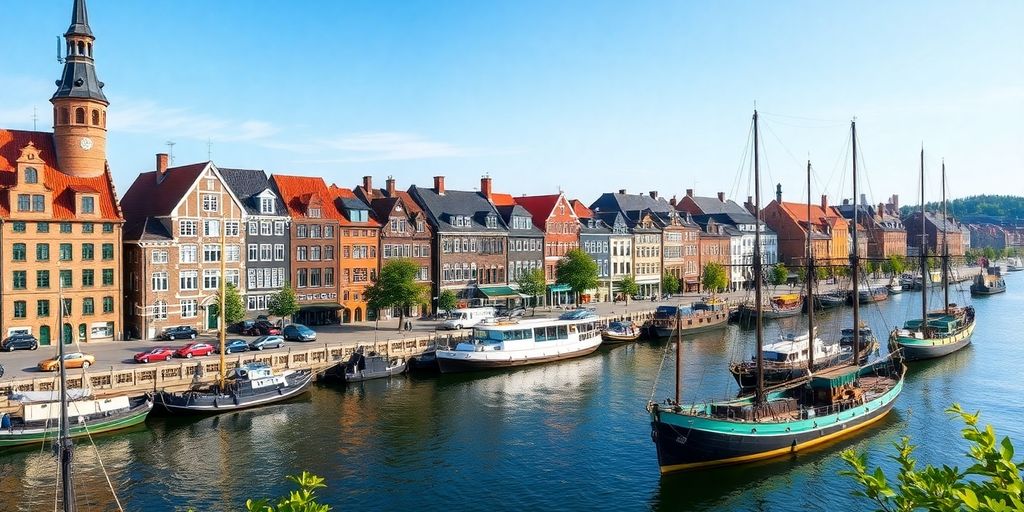Unlocking Wisdom: T.E. Lawrence’s Seven Pillars

T.E. Lawrence, often known as Lawrence of Arabia, is a name that echoes through history, especially when you talk about the Arab Revolt during World War I. His book, ‘The Seven Pillars of Wisdom,’ is not just a memoir but a vivid account of his experiences and the complex dynamics between the Arabs and the British. This article takes you on a journey through the significant places and figures that played a vital role in Lawrence’s journey, from the vast deserts of Wadi Rum to the strategic city of Damascus.
Key Takeaways
- The book offers an insider’s view of the Arab Revolt, detailing Lawrence’s role in the conflict.
- Lawrence’s experiences in Wadi Rum highlight the harsh realities of desert warfare.
- The capture of Aqaba was a turning point in the revolt, showcasing strategic brilliance.
- Damascus was not just a military target but a symbol of Arab unity and independence.
- The Hejaz Railway was a critical supply line, and its disruption was key to the revolt’s success.
1. Seven Pillars of Wisdom
The book "Seven Pillars of Wisdom" by T.E. Lawrence is a gripping memoir that recounts his experiences during the Arab Revolt from 1916 to 1918. This work is not just a historical account; it’s an exploration of the complex relationships and strategic maneuvers that defined the struggle against the Ottoman Empire. Lawrence’s narrative is both personal and political, weaving together his own internal conflicts with the broader challenges of war.
Key Themes
- Leadership and Strategy: Lawrence’s role in the revolt highlights his ability to unite disparate tribes and lead them in guerrilla warfare, leveraging the harsh desert terrain to their advantage.
- Cultural Interactions: The memoir delves into the intricate dynamics between the British and the Arab forces, showcasing both cooperation and tension.
- Personal Reflection: Lawrence’s writing is deeply introspective, offering insights into his thoughts and feelings amidst the chaos of war.
Historical Context
The Arab Revolt was a pivotal moment in the Middle Eastern theater of World War I. With the support of Emir Faisal, Lawrence orchestrated attacks from Aqaba to Damascus, disrupting Ottoman supply lines and contributing to the eventual success of the revolt. His strategies, often unconventional, were instrumental in the campaign’s achievements.
"Seven Pillars of Wisdom" is more than just a war story; it’s a profound reflection on the nature of leadership and the moral complexities of conflict. Lawrence’s experiences offer a unique perspective on the challenges of uniting diverse groups under a common cause.
Legacy
The legacy of "Seven Pillars of Wisdom" endures, not only as a historical document but as a testament to the enduring power of storytelling. Lawrence’s ability to capture the essence of the Arab Revolt has left an indelible mark on both literature and history, inspiring countless readers and scholars alike.
2. Wadi Rum
Wadi Rum, often called the "Valley of the Moon," is a sprawling desert landscape in southern Jordan that captivates with its vastness and beauty. This enchanting place is a tapestry of ancient history and stunning geology. The red and orange sandstone mountains, towering like majestic sculptures, offer a dramatic backdrop to the endless stretches of sand.
The Landscape
- Mountains and Cliffs: The area is dotted with towering cliffs and mountains, carved by nature into striking shapes and formations.
- Sand Dunes: Sweeping sand dunes create a dynamic landscape, shifting with the winds and offering a playground for adventurers.
- Canyons and Gorges: Narrow canyons and deep gorges invite exploration, each telling stories of the forces that shaped them.
Historical Significance
Wadi Rum has been a crossroads for various cultures throughout history. Ancient petroglyphs and inscriptions, etched into the rocks by the Nabataeans and other civilizations, provide a glimpse into the past. These markings reveal the area’s importance as a trade route and a cultural melting pot.
Modern Adventures
Today, Wadi Rum is a haven for adventure seekers and nature enthusiasts. Visitors can engage in activities such as:
- Rock Climbing: The rugged cliffs offer challenging routes for climbers of all skill levels.
- Camel Rides: Experience the desert like the Bedouins of old, traversing the sands on camelback.
- Stargazing: With minimal light pollution, Wadi Rum is an ideal spot for observing the night sky.
"The silence of the desert is profound, broken only by the whisper of the wind and the soft tread of camels."
Cultural Experience
Visitors to Wadi Rum can immerse themselves in Bedouin culture. Staying in a traditional Bedouin camp, enjoying local cuisine, and listening to stories around a campfire offer a unique cultural experience. Hospitality is a cornerstone of Bedouin life, and guests often leave with lasting memories and newfound friendships.
Wadi Rum is not just a destination; it’s an experience that resonates with the spirit of adventure and the allure of the unknown. Whether you’re drawn by its natural beauty or its rich history, Wadi Rum promises an unforgettable journey.
3. Aqaba
Aqaba, a city on the northeastern tip of the Red Sea, played a pivotal role in the Arab Revolt during World War I. Its capture marked a turning point for the Arab forces led by T.E. Lawrence and Prince Faisal.
The Strategic Importance of Aqaba
The city’s location made it a crucial objective for the Arab forces. Situated at the crossroads of trade routes and military supply lines, Aqaba’s harbor provided a gateway to the interior of the Arabian Peninsula. Control over Aqaba meant better access to resources and supplies, which were vital for sustaining the revolt.
The Battle for Aqaba
The capture of Aqaba was not a straightforward military engagement. Lawrence and his forces undertook a daring overland journey through the harsh desert, avoiding direct confrontation with the Ottoman forces. This surprise attack from the landward side, which the Turks had left lightly defended, allowed the Arabs to seize the city with minimal resistance.
Aftermath and Impact
The successful capture of Aqaba opened up new strategic possibilities for the Arab Revolt. It enabled a direct line of communication and supply between the Arab forces and the British, facilitating further military operations against the Ottoman Empire.
Aqaba was more than just a military victory; it symbolized the growing strength and determination of the Arab forces in their quest for autonomy.
The fall of Aqaba also demonstrated the effectiveness of guerilla tactics and the importance of strategic planning in warfare. With Aqaba secured, the Arab forces could focus on their next objectives, ultimately contributing to the broader success of the revolt.
4. Damascus
Damascus, a city with an ancient soul, was more than just a strategic target during the Arab Revolt. It was a symbol of hope and a beacon for future Arab governance. The capture of Damascus marked a pivotal moment in the Arab Revolt, as it signaled the end of Ottoman control and the beginning of a new era.
The Strategic Importance
Damascus was not just any city; it was the heart of communication lines. The railway from Damascus to Deraa and Amman was crucial for controlling the region. By disrupting these lines, the Allies could cripple Ottoman movements and supply routes.
The Entry into Damascus
The entry into Damascus was orchestrated with precision. Feisal’s forces, along with the Allied troops, were careful to present themselves as liberators, not conquerors. The local committee, prepared for months, swiftly took over the administration, ensuring a smooth transition.
- The Arab flag was raised on the Town Hall even before the last of the Ottoman forces left.
- With the help of local leaders like Shukri el Ayubi, the new government was quickly established.
- By midnight, thousands of Arab troops were in the city, securing key positions.
Challenges of Governance
Establishing a new government was not without its challenges. Rebels, though successful in war, were not naturally suited to governance. Feisal faced the difficult task of forming a government that could sustain peace and stability.
The new Arab Government aimed to harness the energy of the rebellion into a stable administration. This involved integrating those who had remained under Ottoman rule, as their support was essential for the new state’s foundation.
The Legacy of Damascus
The fall of Damascus was more than a military victory; it was a turning point in Arab history. It represented the hope for self-determination and the end of foreign domination. The events in Damascus set the stage for future Arab governance, laying the groundwork for what many hoped would be a united Arab nation.
In conclusion, the capture of Damascus was a complex operation that required not only military prowess but also political acumen. It was a testament to the enduring spirit of the Arab Revolt and a significant step towards achieving independence.
5. Hejaz Railway
The Hejaz Railway was more than just a track of steel and wood stretching across the desert; it was a lifeline, a strategic asset, and a symbol of control for the Ottoman Empire during World War I. Its significance extended beyond mere transportation, impacting the dynamics of the Arab Revolt.
A Strategic Target
The railway’s primary purpose was to facilitate the movement of troops and supplies from Damascus to Medina, making it a crucial asset for the Ottomans. However, this also made it a prime target for the Arab forces led by T.E. Lawrence and Emir Faisal. By disrupting this vital line, they aimed to weaken Ottoman control over the region.
Impact on the Arab Revolt
The attacks on the Hejaz Railway were not just about causing physical damage; they were a psychological blow to the Ottomans. These raids, often executed with precision, demonstrated the growing strength and coordination of the Arab forces. The disruption of the railway lines forced the Ottomans to divert resources and manpower, aiding the larger objectives of the Arab Revolt.
Tactics and Techniques
The sabotage of the railway involved ingenious tactics. Lawrence and his men became adept at mining the tracks, using explosives to derail trains and destroy locomotives. This not only hampered the movement of troops but also instilled fear and uncertainty among the Ottoman ranks.
The Hejaz Railway, once a symbol of Ottoman power, became a testament to the resilience and strategic acumen of the Arab forces. Through a series of daring raids, they turned the railway from an asset into a liability for their adversaries.
Long-term Consequences
The sustained attacks on the railway had long-term implications. The disruption of supply lines contributed to the eventual withdrawal of Ottoman forces from the region, paving the way for the establishment of new political entities. The railway, once a tool of imperial ambition, became a relic of a bygone era, marking the shifting sands of power in the Middle East.
In conclusion, the Hejaz Railway played a pivotal role in the Arab Revolt, not just as a physical structure but as a strategic focal point that influenced the course of history in the region. The strategic sabotage of the railway was a key factor in the success of the Arab forces, highlighting the importance of tactical ingenuity in warfare.
6. Emir Faisal

Emir Faisal, a central figure in the Arab Revolt, is remembered for his leadership and diplomatic skills. Born into the Hashemite family, Faisal was the third son of Sherif Hussein, the Grand Sharif of Mecca. His upbringing in a politically charged environment shaped him into a leader who could navigate complex social and political landscapes with ease.
Faisal’s role in the Arab Revolt was pivotal. He was instrumental in orchestrating the revolt against the Ottoman Empire during World War I, working closely with T.E. Lawrence, better known as Lawrence of Arabia. Faisal’s ability to unite diverse Arab tribes under a common cause was nothing short of remarkable. His leadership was not just about military strategy; it was about building alliances and fostering a sense of shared identity among the Arab people.
The Diplomat and Statesman
Faisal’s diplomatic prowess was evident in his dealings with both Arab leaders and Western powers. He understood the importance of securing international support for the Arab cause. Faisal’s participation in the Paris Peace Conference in 1919 showcased his commitment to advocating for Arab independence on the global stage.
Legacy and Impact
The legacy of Emir Faisal extends beyond the battlefield. His efforts laid the groundwork for the modern Middle East. Faisal’s vision of an independent Arab state influenced the political landscape of the region for decades to come. He became the first King of Iraq in 1921, a testament to his enduring influence and leadership.
Faisal once said, "Unity is strength, division is weakness." This simple yet profound statement encapsulates his approach to leadership and his enduring legacy.
In summary, Emir Faisal was a leader who combined military acumen with diplomatic tact. His contributions to the Arab Revolt and his vision for the Arab world have left an indelible mark on history. His story is a reminder of how leadership can shape the course of history, even in the most challenging times.
7. Arab Revolt

The Arab Revolt is a fascinating chapter in history, marked by a struggle for independence and identity. It was a daring gamble, a bold move against the Ottoman Empire that aimed to free Arab lands from foreign rule. Fortune favored the brave, and this revolt became a symbol of hope and determination for the Arab people.
The Strategy Behind the Revolt
Initially, the focus was on the Hejaz region, with the capture of Medina being a significant goal. However, as the revolt unfolded, the emphasis shifted towards Syria, recognizing its political and cultural importance. This shift was not just about geography but also about adapting strategies to the realities of irregular warfare. The Arabs, under the guidance of leaders like T.E. Lawrence, understood that traditional military tactics had limitations in the vast desert landscape. Instead, they leveraged their mobility and knowledge of the terrain to disrupt the Ottoman forces effectively.
Collaboration and Challenges
The revolt was not without its challenges. The Arabs and their British allies often had differing priorities. While the British saw the capture of cities like Medina as crucial, the Arab leaders, including Lawrence, argued for a focus on more strategic targets, such as the Hejaz Railway. This railway was vital for Turkish resupply efforts, and its disruption was key to supporting British advances in Palestine.
The Legacy of the Revolt
The Arab Revolt’s legacy is complex. It was a time of optimism and promise, yet also one of disillusionment when the hoped-for independence did not fully materialize. Despite this, the revolt remains a "lucent inspiration" for future generations, a testament to the enduring spirit of those who fought for their freedom.
The Arab Revolt was more than a military campaign; it was a movement that united diverse tribes and people under a common cause. It was a testament to the power of unity and the enduring hope for self-determination.
The psychological aspects of totalitarianism provide an interesting contrast to the Arab Revolt, as both involve themes of control and power, albeit in very different contexts. The revolt’s emphasis on freedom and independence starkly opposes the oppressive nature of totalitarian regimes, highlighting the universal desire for autonomy and self-rule.
Conclusion
Wrapping up our journey through T.E. Lawrence’s "Seven Pillars of Wisdom," it’s clear that this isn’t just a war story. It’s a deep dive into the mind of a man caught between two worlds, trying to make sense of his place in a chaotic time. Lawrence’s experiences during the Arab Revolt show us the complexity of leadership and the weight of responsibility. His narrative isn’t just about battles and strategies; it’s about the human spirit, the struggle for identity, and the quest for meaning in the midst of conflict. As we close this chapter, we’re left with a richer understanding of the past and a reminder of the timeless nature of these struggles. Lawrence’s tale is a testament to the enduring power of personal stories in shaping our view of history.
Frequently Asked Questions
What is the ‘Seven Pillars of Wisdom’ about?
The ‘Seven Pillars of Wisdom’ is a book by T.E. Lawrence that tells the story of his experiences during the Arab Revolt against the Ottoman Empire in World War I.
Who was T.E. Lawrence?
T.E. Lawrence, also known as Lawrence of Arabia, was a British officer who played a key role in the Arab Revolt during World War I.
Why is Wadi Rum significant in Lawrence’s story?
Wadi Rum is a desert area where Lawrence was based during the Arab Revolt. It is known for its stunning landscapes and historical significance.
What happened at Aqaba in the Arab Revolt?
Aqaba was a strategic location captured by Lawrence and his Arab allies, marking a turning point in the Arab Revolt against the Ottoman Empire.
Who was Emir Faisal?
Emir Faisal was a leader of the Arab forces during the revolt, working closely with Lawrence to fight against Ottoman rule.
What was the Hejaz Railway’s role in the revolt?
The Hejaz Railway was a key target during the Arab Revolt, as disrupting it helped to weaken Ottoman forces.








Responses